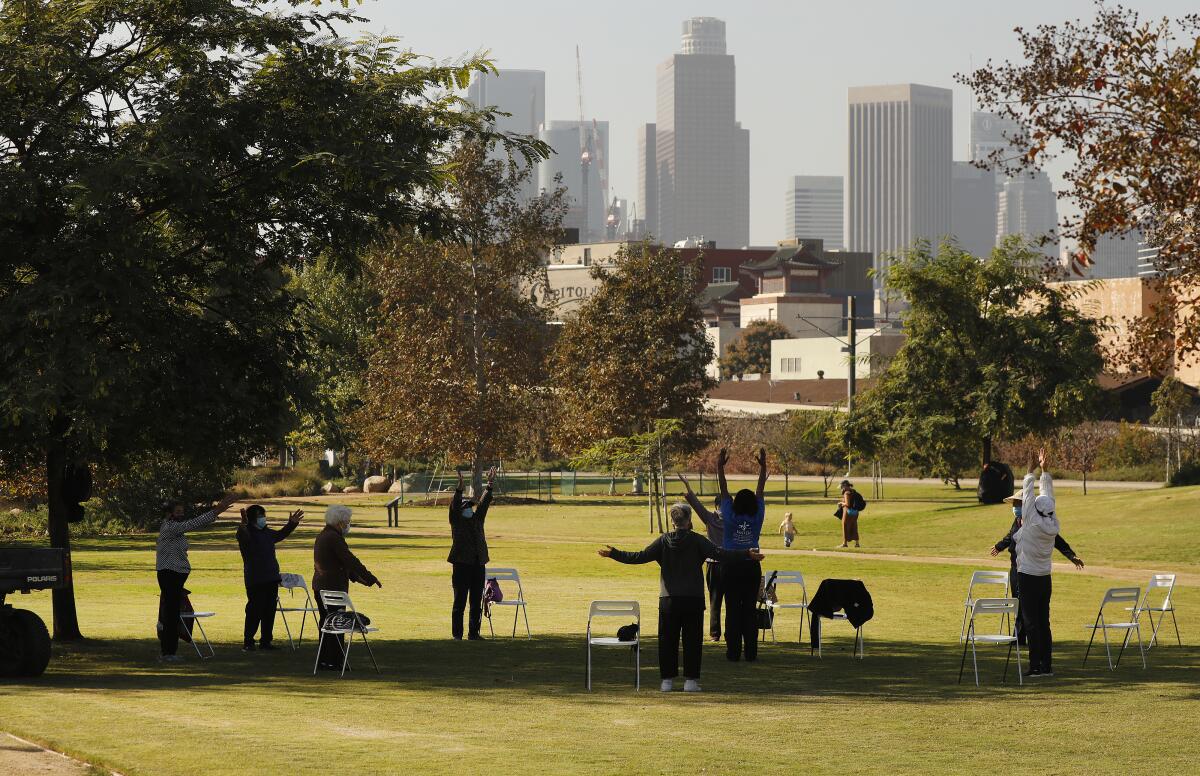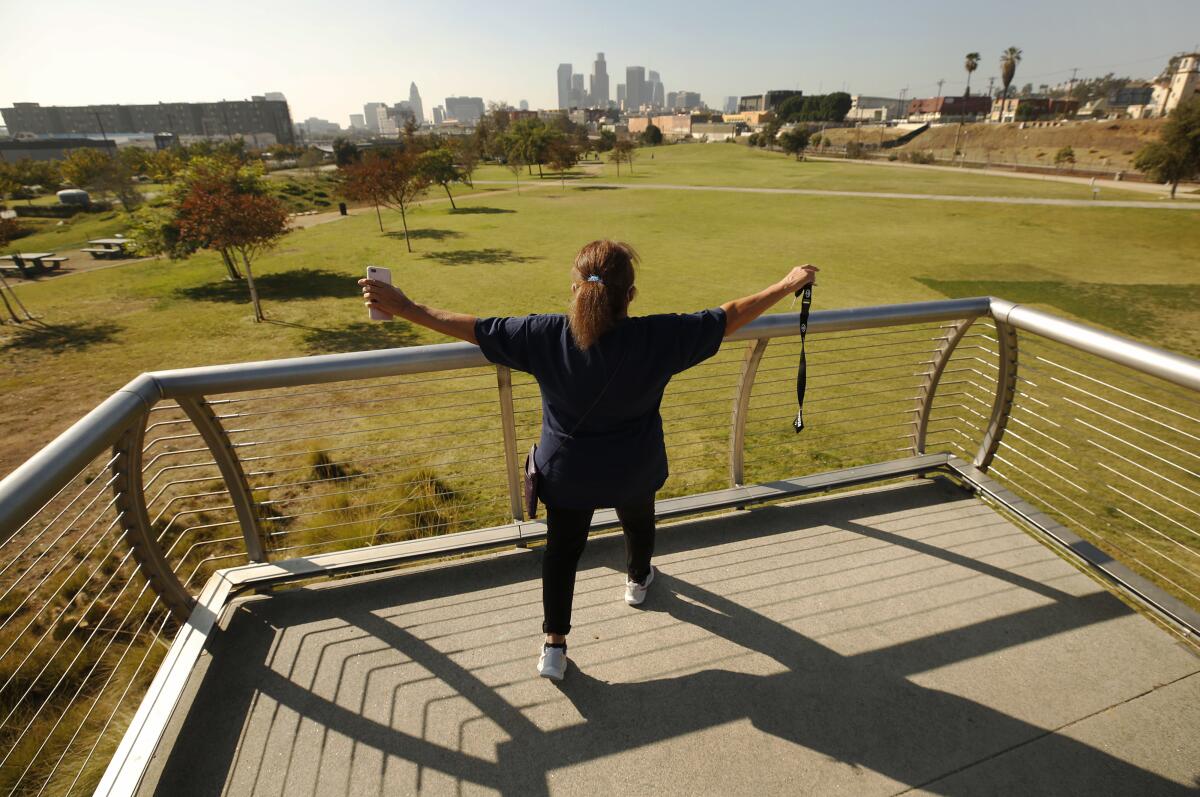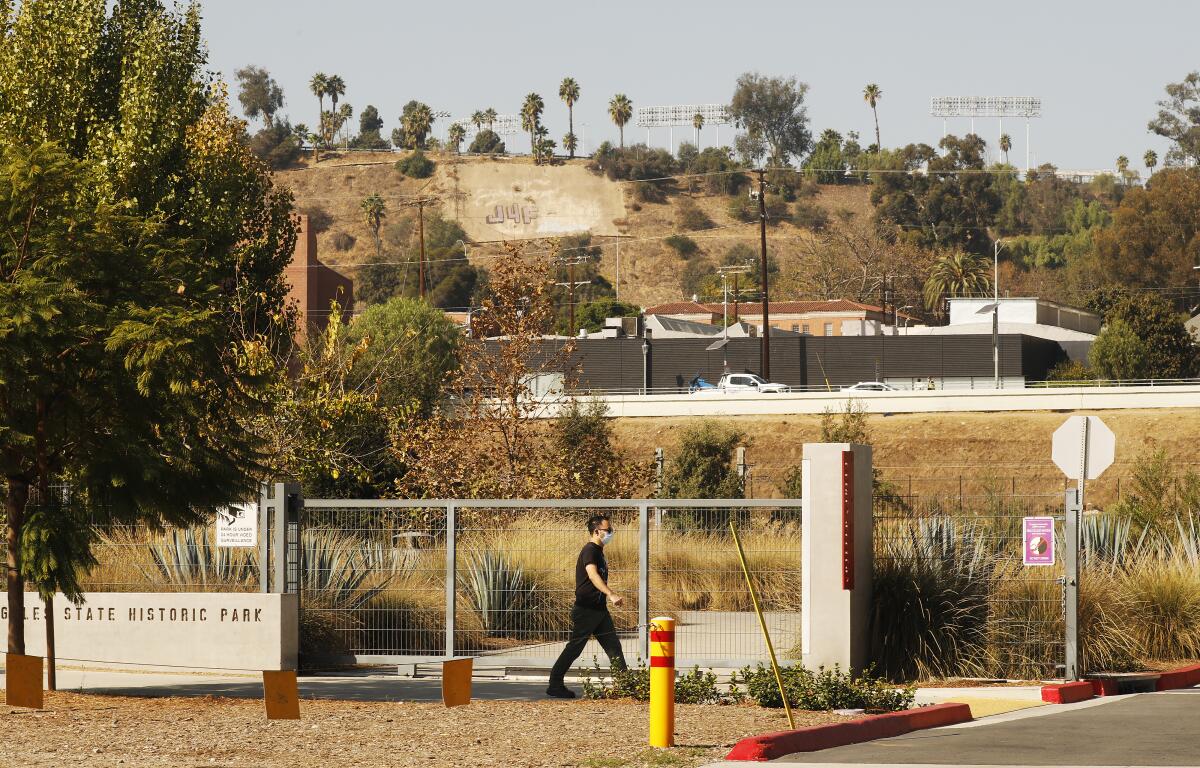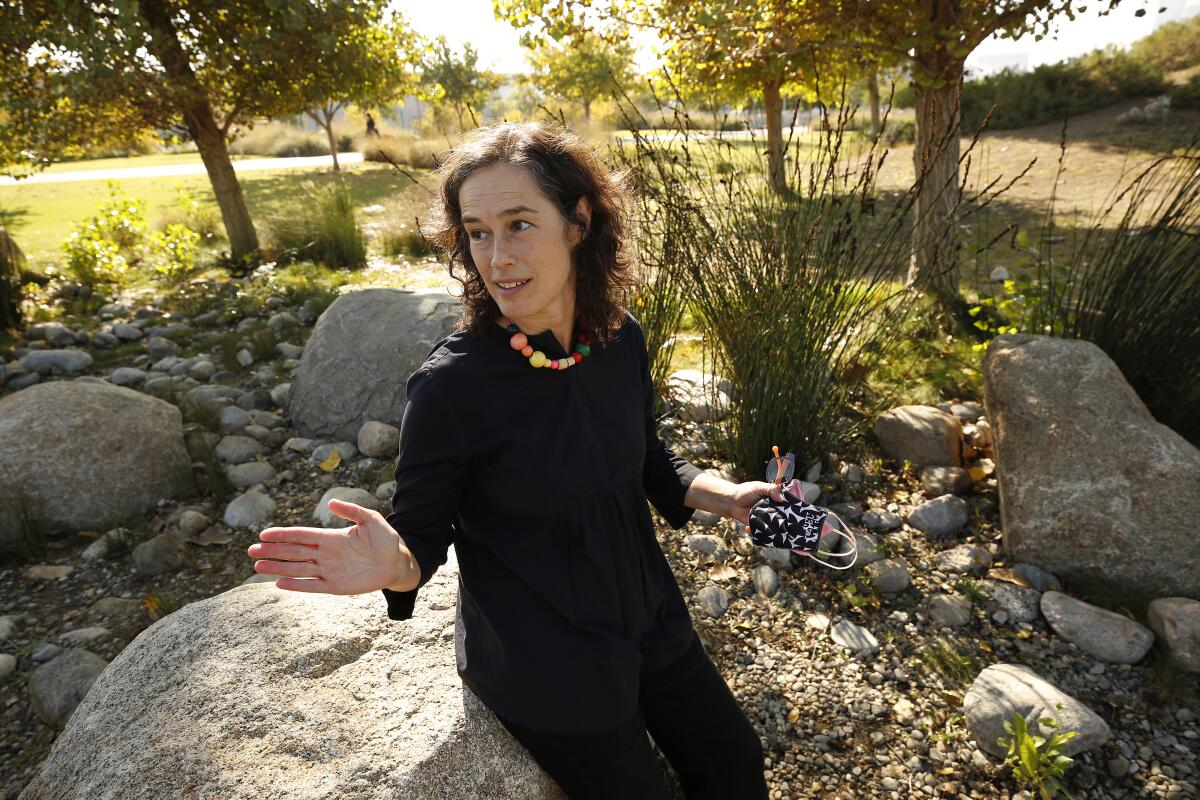Proposed aerial gondola for Dodgers fans ignites controversy at Los Angeles State Historic Park

- Share via
To the average visitor, Los Angeles State Historic Park looks to be an urban oasis — a serene expanse of rolling grass and shady glens tucked between Chinatown and the Los Angeles River.
But the park’s assorted picnickers, joggers and children flying kites belie a long history of conflict, one that continues to this day.
The park, which opened on Earth Day 2017, is just a few blocks from the site where hundreds of white rioters killed 19 Chinese men and boys on Oct. 24, 1871. And just to the north, developers and city officials forced more than a thousand mostly Latino families from Chavez Ravine in the 1950s to build the stadium where the Dodgers now play.
In the 1990s, the 32-acre tract had become a legal battleground when the city planned to transform it into a warehouse center. Yielding to pressure from activists, California State Parks acquired the property for a park in 2001. It was built 16 years later with $20 million in voter-approved Proposition 40 bond funds and touted as a model for solving land use battles in metropolitan areas.
Now, a company funded by former Dodgers owner Frank McCourt has proposed a $125-million electric aerial gondola system to ferry baseball fans and concertgoers from Union Station over the park to Dodger Stadium — and community activists have weighed in with a barrage of concerns.
“This park is a tribute not just to the historic struggle that created it but to the communities that continue to fight for it,” said Jon Christensen, an environmental historian at UCLA.
“Nothing comes without struggle,” he added. “But I hope that developers who will reap the value of the park for their projects respect its historic nature and realize their obligations to those communities.”
Among the community members is Xochitl Manzanilla, 78, a park volunteer who lives in a nearby public housing development in Chinatown.

Standing on a pedestrian bridge in the park with panoramic views of the L.A. skyline, she wagged a finger in disapproval and said, “We don’t want gondolas in this park. People come here to enjoy nature, open space and fly kites high up in the sky.”
That kind of talk has the developer bracing for a fierce debate as the Los Angeles Aerial Rapid Transit project enters the environmental review phase.
The project envisions two competing proposals: the southern Broadway alignment and the Spring Street alignment. Both would encroach upon and cross portions of the park with a passenger tower, stanchions, aerial cables and gondola cars able to whisk some 5,500 people per hour from Union Station to the stadium in about seven minutes, the developer said. Proponents say it would help reduce traffic and improve air quality.
The Spring Street alignment would have the biggest effect on the park’s recreational opportunities, views and archaeological resources, according to state parks officials. Conversely, it would provide the most direct path with the fewest turns and potential clashes with property owners for the developer, officials said.
Cindy Starret, an attorney and manager of the project, said that the developer “is happy” to help state parks officials and local stakeholders secure funding for improvements including a pedestrian bridge linking the park to a nearby Gold Line station.
“Our approach is to have a partnership,” Starret said. “We are offering to help with the cost of the pedestrian bridge. If the state wants more say, restrooms, we can help with that. It has proposed more tree planting. We can help with that too.”
But a big worry buzzing around the park is the scale and design of a passenger station to be built on city property just south of the park boundary, where gondola cars would make a 90-degree turn off Spring Street, cross over the mid-section of the park and continue up to their destination in the stadium parking lot owned by the McCourt family.

Critics say developer’s renderings suggest that the station would be about 75 feet tall with a huge, curved roof (designed to mimic the shape of a bird in flight) that would tower over the park’s nearby visitor pavilion, ranger station, promenade and orchards. Its cables and steady stream of moving gondola cars would block views of the park’s rolling grasslands, urban forests and downtown skyscrapers for people on foot.
In a recent letter to the Los Angeles County Metropolitan Transportation Authority, which has agreed to act as the lead agency for the environmental impact report, Patricia Perez, board chair of the nonprofit Los Angeles River State Park Partners, complained that “these unobstructed views are now being promoted by the developer as a gondola benefit.”
The gondola rides, which would cost about $10 each way, would fly roughly 30 feet over historic sites including where a Spanish expeditionary force led by Capt. Gaspar de Portolá forded the L.A. River in 1759 and set up a base camp near the Native American village of Yang-Na.
Across that terrain ran the Zanja Madre, a web of brick and mortar conduits fed by a large water wheel that carried irrigation water in the young city. Entombed in dirt nearby are remnants of a passenger station built in 1876 to serve the newly arrived Southern Pacific Railroad.
Supporters of the gondola line include Martin Farfan, president of Cathedral High School, just a stone’s throw from the northwestern corner of the park.
“I love the Dodgers,” said Farfan, whose school receives donations of $5,000 to $10,000 each year from the McCourt family to help provide scholarships for students. “Beyond that, I’m in favor of anything we can do to get vehicles off Los Angeles’ freeways.”
But opponents worry the project could transform the surrounding working-class neighborhoods into a commercial center festooned with corporate advertising. The area, after all, is already struggling to contain gentrification triggered by creation of the park on what had been an abandoned downtown rail yard.

It’s not a development plan that Julia Meltzer, a community activist and founder of Clockshop, a nonprofit arts organization in nearby Elysian Valley, will be keen to promote.
Sitting on a boulder in the proposed path of the gondola line on a recent weekday, she looked up at western bluebirds flitting in the highest branches of 20-foot sycamore trees. From the elevated windows of a crowded gondola car, she said, the trees would tell a less vibrant story.
“Project promoters have the nerve to say, ‘Think of the views you’ll get from the gondolas,’” she said with a deep sigh. “We say, ‘Think of the views you’ll destroy at a park people fought like hell to create.’”
More to Read
Sign up for Essential California
The most important California stories and recommendations in your inbox every morning.
You may occasionally receive promotional content from the Los Angeles Times.











